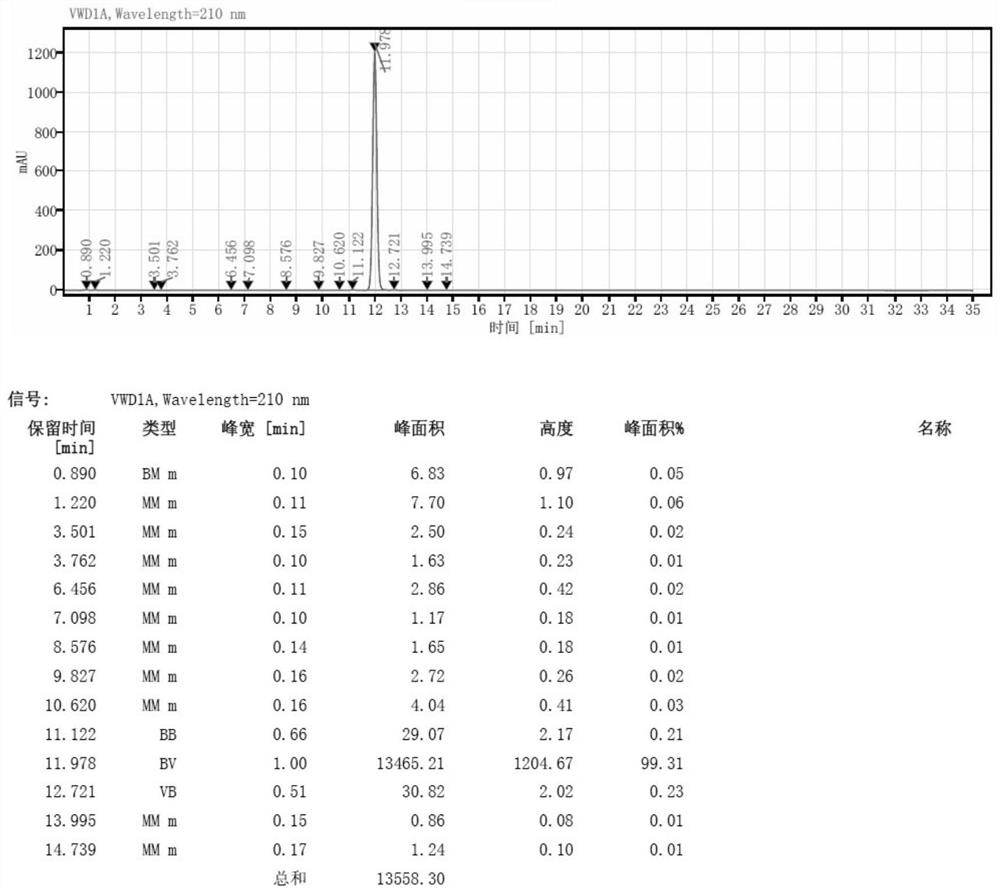A crystal form of a key intermediate of a btk kinase inhibitor and a preparation method thereof
A technology of kinase inhibitors and intermediates, which is applied in organic chemistry methods, organic chemistry, antineoplastic drugs, etc., can solve the problems of BTK kinase inhibitor purification methods such as difficulty in scaling up, high cost, unfavorable large-scale production, etc., and achieve the production process Stable, repeatable and controllable, good crystal form stability, satisfying the effect of production, transportation and storage
- Summary
- Abstract
- Description
- Claims
- Application Information
AI Technical Summary
Problems solved by technology
Method used
Image
Examples
Embodiment 1
[0054] (R)-1-(1-(tert-butoxyacyl)pyrrolidin-3-yl)-3-cyano-4-(4-(2,6-difluorophenoxy)phenyl)-1H- Preparation of ethyl pyrrole-2-carboxylate
[0055] (R)-1-(1-(tert-butoxyacyl)pyrrolidin-3-yl)-3-cyano-4-bromo-1H-pyrrole-2-carboxylic acid ethyl ester (1.98g, 4.8mmol), I 2 (1.60g, 4.8mmol) and K 3 PO 4 ·3H 2 O (1.88g, 7.2mmol) in 1,4-dioxane / water (60mL / 6mL), after degassing the solution with nitrogen, then add Pd under the protection of nitrogen 2 (dba) 3 (220mg, 0.24mmol) and P(Cy) 3 (140mg, 0.48mmol), and then heated to reflux for 16h. After the reaction was completed, it was cooled to room temperature, the solid was filtered off, and the filtrate was concentrated. The residue was purified by silica gel chromatography (eluent: dichloromethane), and evaporated under reduced pressure to obtain 0.57 g of off-white solid (R)-1-(1-(tert-butoxyacyl)pyrrolidin-3-yl)- ethyl 3-cyano-4-(4-(2,6-difluorophenoxy)phenyl)-1H-pyrrole-2-carboxylate. HPLC: 99.31%, max. simple: 0.21%. ...
Embodiment 2
[0057] Take 1.0 g of the compound of formula (I) (the crude product prepared according to Example 1) and add it to a 25 mL single-necked bottle, add 2 mL of absolute ethanol, heat to reflux to dissolve, stop heating, cool and crystallize, suction filter the next day, and dry under reduced pressure After drying, 715 mg of white solid was obtained, and the yield was 71.5%. HPLC: 99.73%, max. simple: 0.04%. The X-ray diffraction spectrum of the crystalline sample is shown in image 3 . The X-ray powder diffraction pattern is characterized at 2θ values of approximately 5.52, 8.62, 9.34, 11.85, 14.36, 14.52, 15.25, 17.16, 18.79, 19.02, 20.02, 20.18, 20.49, 20.79, 22.44, 23.79, 24.02, 24.29 and 28.18 peaks, and their characteristic peak positions are shown in Table 1 below. See the DSC spectrum Figure 4 , with a sharp melting endothermic peak at 97.92°C, this crystal form is defined as crystal form II. The crystalline form II contains at least 97% or more of the crystalline ...
Embodiment 3
[0062] Take 1.0g of the compound of formula (I) (the crude product prepared according to Example 1) and add it to a 25mL single-necked bottle, add 1.5mL of absolute ethanol, heat to reflux to dissolve, stop heating, cool and crystallize, the next day, suction filter and dry 868 mg of white solid was obtained, and the yield was 86.8%. The X-ray diffraction pattern and the DSC pattern of the crystalline sample are studied and compared, and the product is determined to be crystal form II.
PUM
 Login to View More
Login to View More Abstract
Description
Claims
Application Information
 Login to View More
Login to View More - R&D
- Intellectual Property
- Life Sciences
- Materials
- Tech Scout
- Unparalleled Data Quality
- Higher Quality Content
- 60% Fewer Hallucinations
Browse by: Latest US Patents, China's latest patents, Technical Efficacy Thesaurus, Application Domain, Technology Topic, Popular Technical Reports.
© 2025 PatSnap. All rights reserved.Legal|Privacy policy|Modern Slavery Act Transparency Statement|Sitemap|About US| Contact US: help@patsnap.com



